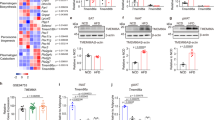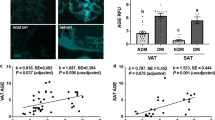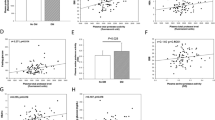Abstract
Cysteine proteases play an important part in human pathobiology1. This report shows the participation of cathepsin L (CatL) in adipogenesis and glucose intolerance. In vitro studies demonstrate the role of CatL in the degradation of the matrix protein fibronectin, insulin receptor (IR) and insulin-like growth factor-1 receptor (IGF-1R), essential molecules for adipogenesis and glucose metabolism2,3,4,5. CatL inhibition leads to the reduction of human and murine pre-adipocyte adipogenesis or lipid accumulation, protection of fibronectin from degradation, accumulation of IR and IGF-1R β-subunits, and an increase in glucose uptake. CatL-deficient mice are lean and have reduced levels of serum glucose and insulin but increased levels of muscle IR β-subunits, fibronectin and glucose transporter (Glut)-4, although food/water intake and energy expenditure of these mice are no less than their wild-type littermates. Importantly, the pharmacological inhibition of CatL also demonstrates reduced body weight gain and serum insulin levels, and increased glucose tolerance, probably due to increased levels of muscle IR β-subunits, fibronectin and Glut-4 in both diet-induced obese mice and ob/ob mice. Increased levels of CatL in obese and diabetic patients suggest that this protease is a novel target for these metabolic disorders.
This is a preview of subscription content, access via your institution
Access options
Subscribe to this journal
Receive 12 print issues and online access
$209.00 per year
only $17.42 per issue
Buy this article
- Purchase on Springer Link
- Instant access to full article PDF
Prices may be subject to local taxes which are calculated during checkout





Similar content being viewed by others
References
Roberts, R. Lysosomal cysteine proteases: structure, function and inhibition of cathepsins. Drug News Perspect. 18, 605–614 (2005).
O'Connor, K.C., Song, H., Rosenzweig, N., & Jansen, D.A. Extracellular matrix substrata alter adipocyte yield and lipogenesis in primary cultures of stromal-vascular cells from human adipose. Biotechnol. Lett. 25, 1967–1972 (2003).
Gagnon, A.M., Chabot, J., Pardasani, D., & Sorisky, A. Extracellular matrix induced by TGFbeta impairs insulin signal transduction in 3T3-L1 preadipose cells. J. Cell Physiol. 175, 370–378 (1998).
Chang, P. Y., Goodyear, L. J., Benecke, H., Markuns, J. S., & Moller, D. E. Impaired insulin signaling in skeletal muscles from transgenic mice expressing kinase-deficient insulin receptors. J. Biol. Chem. 270, 12593–12600 (1995).
Di Cola, G., Cool, M. H., & Accili, D. Hypoglycemic effect of insulin-like growth factor-1 in mice lacking insulin receptors. J. Clin. Invest. 99, 2538–2544 (1997).
MacDougald, O. A., & Lane, M. D. Transcriptional regulation of gene expression during adipocyte differentiation. Annu. Rev. Biochem. 64, 345–373 (1995).
Chiellini, C. et al. Identification of cathepsin K as a novel marker of adiposity in white adipose tissue. J. Cell. Physiol. 195, 309–321 (2003).
Sukhova, G. K., Shi, G. P., Simon, D. I., Chapman, H. A., & Libby, P. Expression of the elastolytic cathepsins S and K in human atheroma and regulation of their production in smooth muscle cells. J. Clin. Invest. 102, 576–583 (1998).
Katunuma, N. et al. Structure based development of novel specific inhibitors for cathepsin L and cathepsin S in vitro and in vivo. FEBS Lett. 458, 6–10 (1999).
Wu, Z. et al. Cross-regulation of C/EBP alpha and PPAR gamma controls the transcriptional pathway of adipogenesis and insulin sensitivity. Mol. Cell 3, 151–158 (1999).
Punturieri, A. et al. Regulation of elastinolytic cysteine proteinase activity in normal and cathepsin K-deficient human macrophages. J. Exp. Med. 192, 789–799 (2000).
Spiegelman, B.M., & Ginty, C.A. Fibronectin modulation of cell shape and lipogenic gene expression in 3T3-adipocytes. Cell 35, 657–666 (1983).
Marshall, S., Green, A., & Olefsky, J. M. Evidence for recycling of insulin receptors in isolated rat adipocytes. J. Biol. Chem. 256, 11464–11470 (1981).
Knutson, V. P., Donnelly, P. V., Balba, Y., & Lopez-Reyes, M. Insulin resistance is mediated by a proteolytic fragment of the insulin receptor. J. Biol. Chem. 270, 24972–24981 (1995).
Rosen, E.D., & MacDougald, O.A. Adipocyte differentiation from the inside out. Nature Rev. Mol. Cell Biol. 7, 885–896 (2006).
Grabowskal, U., Chambers, T.J., & Shiroo, M. Recent developments in cathepsin K inhibitor design. Curr. Opin. Drug Discov. Devel. 8, 619–630 (2005).
Klemm, D. J. et al. Insulin-induced adipocyte differentiation. Activation of CREB rescues adipogenesis from the arrest caused by inhibition of prenylation. J. Biol. Chem. 276, 28430–28435 (2001).
Shi, G.P., Munger, J.S., Meara, J.P., Rich, D.H., & Chapman, H.A. Molecular cloning and expression of human alveolar macrophage cathepsin S, an elastinolytic cysteine protease. J. Biol. Chem. 267, 7258–7262 (1992).
Nakagawa, T. et al. Cathepsin L: critical role in Ii degradation and CD4 T cell selection in the thymus. Science 280, 450–453 (1998).
Van Heek, M. et al. Diet-induced obese mice develop peripheral, but not central, resistance to leptin. J. Clin. Invest. 99, 385–390 (1997).
Ahima, R.S., & Flier, J.S. Leptin. Annu. Rev. Physiol. 62, 413–437 (2000).
Roth, W. et al. Cathepsin L deficiency as molecular defect of furless: hyperproliferation of keratinocytes and pertubation of hair follicle cycling. FASEB J. 14, 2075–2086 (2000).
Lewis, G. F., Carpentier, A., Adeli, K., & Giacca, A. Disordered fat storage and mobilization in the pathogenesis of insulin resistance and type 2 diabetes. Endocr. Rev. 23, 201–229 (2002).
Huang, X. et al. Impaired cathepsin L gene expression in skeletal muscle is associated with type 2 diabetes. Diabetes 52, 2411–2418 (2003).
Shi, G.P., & Dolganov, G.M. Comprehensive transcriptome of proteases and protease inhibitors in vascular cells. Stroke 37, 537–541 (2006).
Yajima, Y., Sato, M., Sorimachi, H., Inomata, M., Maki, M., & Kawashima, S. Calpain system regulates the differentiation of adult primitive mesenchymal ST-13 adipocytes. Endocrinology 147, 4811–4819 (2006).
Baudry, A., et al. IGF-1 receptor as an alternative receptor for metabolic signaling in insulin receptor-deficient muscle cells. FEBS Lett. 488, 174–178 (2001).
Duttaroy, A. et al. Muscarinic stimulation of pancreatic insulin and glucagon release is abolished in m3 muscarinic acetylcholine receptor-deficient mice. Diabetes 53, 1714–1720 (2004).
Taleb, S., Cancello, R., Clement, K., & Lacasa, D. Cathepsin S promotes human preadipocyte differentiation: possible involvement of fibronectin degradation. Endocrinology 147, 4950–4959 (2006).
Acknowledgements
We thank Drs Christoph Peters and Thomas Reinheckel for providing the CatL-deficient mice; Jingming Chen, David Nolan and Corinne Hurtaud for technical assistance; and Karen Williams and Robert Gregory for editorial assistance. This study is partially supported by grants from the Academic Senate Award (G.-P.S.; University of California San Francisco); a private fund from NMPI, LLC (Damariscotta, Maine); and grants from the National Institutes of Health (HL60942 to G.-P.S. and HL073168 to A.D.). Inserm U872 received a grant from the French National Agency of Research (Obcat N° ANR-05-PCOD-026-01) and from FRM (Foundation of Medical Research)/Danone.
Author information
Authors and Affiliations
Contributions
M.Y. maintained the mouse colonies and performed most of the mouse tissue immunoblot analysis and physiology studies. Y.Z. monitored mouse body weight and performed 3T3-L1 cell-related experiments. J.P. performed all human adipocyte-related experiments. J.S. performed experiments related to inhibitor-treatments in mice and cells. J.L. helped human and mouse adipocyte culture. P.L. helped experimental design and manuscript editing. G.K.S. helped adipocyte immunostaining. A.D. provided human serum samples and helped data analysis and presentation. N.K. provided cathepsin L inhibitors. O.D.P. helped experimental design. B.B.K. provided expert suggestions in experimental design and data presentation. M. G-M. and K.C. suggested fibronectin analysis, performed fibronectin experiments in mouse tissues and contributed to the writing of the manuscript. G-P.S. design the experiment, participated in data analysis and presentation, and prepared the manuscript.
Corresponding author
Supplementary information
Supplementary Information
Supplementary Figure S1 and S2 (PDF 3464 kb)
Rights and permissions
About this article
Cite this article
Yang, M., Zhang, Y., Pan, J. et al. Cathepsin L activity controls adipogenesis and glucose tolerance. Nat Cell Biol 9, 970–977 (2007). https://doi.org/10.1038/ncb1623
Received:
Accepted:
Published:
Issue Date:
DOI: https://doi.org/10.1038/ncb1623
This article is cited by
-
The endoplasmic reticulum stress protein GRP94 modulates cathepsin L activity in M2 macrophages in conditions of obesity-associated inflammation and contributes to their pro-inflammatory profile
International Journal of Obesity (2024)
-
Peripheral cathepsin L inhibition induces fat loss in C. elegans and mice through promoting central serotonin synthesis
BMC Biology (2019)
-
Lysosomes as a therapeutic target
Nature Reviews Drug Discovery (2019)
-
Biology of high single doses of IORT: RBE, 5 R’s, and other biological aspects
Radiation Oncology (2017)
-
Toll-like receptor 7 deficiency protects apolipoprotein E-deficient mice from diet-induced atherosclerosis
Scientific Reports (2017)



